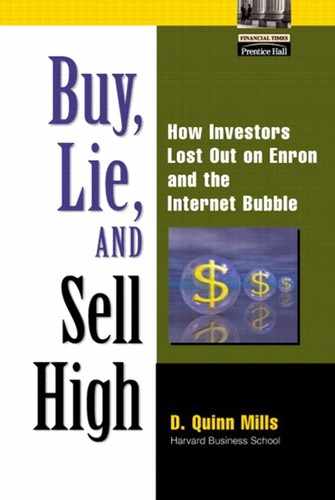The Banks Bend the Rules
To facilitate the bubble, the investment banks changed their rules, just as the venture firms had done. Because so many dot-coms had no profits, the banks shifted their valuation rules to formulas based on sales, not profits. And since there were no profits, the old Wall Street rule of thumb that said don't take a company public until it had at least three quarters of profits was junked.
The result was that companies were going public so early that Wall Streeters had a hard time differentiating winners and losers.[55]
The abandonment of the old rules caused arguments inside the banks: Should this be happening? Is this how we should be valuing companies? There was nothing to back the valuations, but still the retail investor was willing to pay the high prices. So some bankers said, by way of justifying a higher price, that the retail investor values companies differently from the institutional investor.
This line of argument was thoroughly self-serving. The banking analysts and brokers were helping the retail investors to evaluate companies by pushing momentum, not economic value, as the reason to buy IPO shares. Then the banker made a self-serving assumption that the retail investors' behavior was based on independent judgment, and not influenced by the bank's analysts or salespersons, and justified the bank dumping its old rules. That is, the bank said the retail investor is demanding shares in dot-coms and so we have to provide them to him or her, thus ignoring the bank's role in generating the retail investor's enthusiasm for dot-com shares.
And the retail investor was crazy for dot-com stocks. For example, in Hong Kong where investors' reactions were even more exaggerated than in America or Germany, local real estate magnates brought out Internet company stocks. On one offering, Tom.com, the lines of retail investors preparing to invest their life savings were so long outside banks' offices that police had to be called in to prevent riots.[56] Inside the offices were two stacks of documents—applications to buy shares and prospectuses. At the end of the day all the applications to buy were gone, and all the prospectuses remained.
During the bubble in the United States, the percentage of stock owned by retail investors reached a historic high.
The controversies within the banks probably resulted in underpricing of many of the companies actually offered to the public. This underpricing occurred because the offering price represented a compromise between those who supported taking the companies public, and those who opposed it. This was ironic because during the mania it resulted in very large leaps in the price of the shares the moment they hit the street, providing a valuable commodity for investment bankers to allocate—namely, shares in start-ups.
The gross underpricing had a lot to do with incentives. First, the investment banks, and their mutual fund and hedge fund brokerage clients, profited directly and thus had no incentive to correct the problem. Second, corporate insiders—especially senior management, employees, and directors—received options struck at the IPO price and thus benefited from underpricing. Third, those who had the most to lose from underpricing—large shareholders such as founders and venture capitalists—seemed not to care. Only a small portion of the shares were being offered publicly, which limited the loss due to underpricing, and you could argue that the beneficial effects of keeping employees and others happy offset this cost.
Some also argued that a big pop on the opening day would give the stock valuable momentum by gaining public visibility, which would give the company a marketing advantage for its products[57] and would attract a large potential shareholder base. The base would lead to greater research coverage on Wall Street, which would lead to greater capital market access for follow-on financings and even secondary issues to allow existing holders to liquidate their holdings. A temporary high stock price also allowed the VCs to distribute the shares to their fund investors at high market-to-market prices. The trading price on the day of distribution is used to calculate the VC's carry and so matters a lot. Finally, the IPO price is by definition not a market price. It is simply a notional amount set for contractual and payoff purposes. Thus, underpricing per se is not evidence of market failure, the argument goes. It's perverse, but why not?
The answer is that underpricing took money from the companies that went public and distributed it to investors—some of whom were merely short-term holders who were given privileged access by the banks to shares. The run-up in the price of shares which resulted gave false signals about value to the investing public.
Samuel Hayes, a long-term expert observer of the investment banking industry, commented to the Wall Street Journal that at the time of IPOs during the bubble, “the public is taking things at face value, and in the meantime there is a set of under-the-table deals going on that completely distorts the expectations of the individual investor's decision to buy.”[58]
